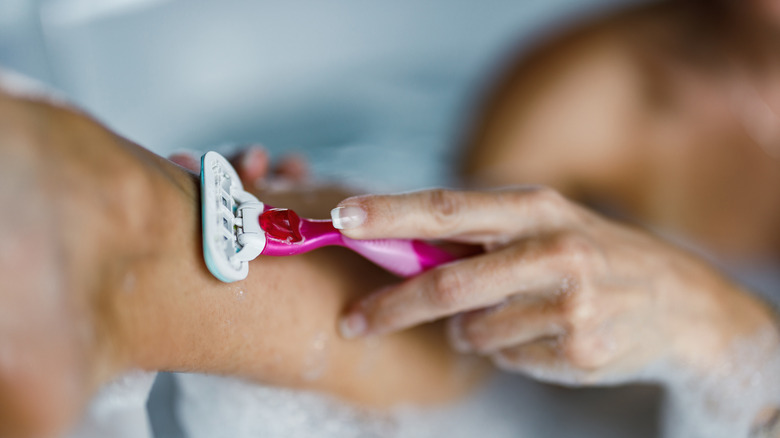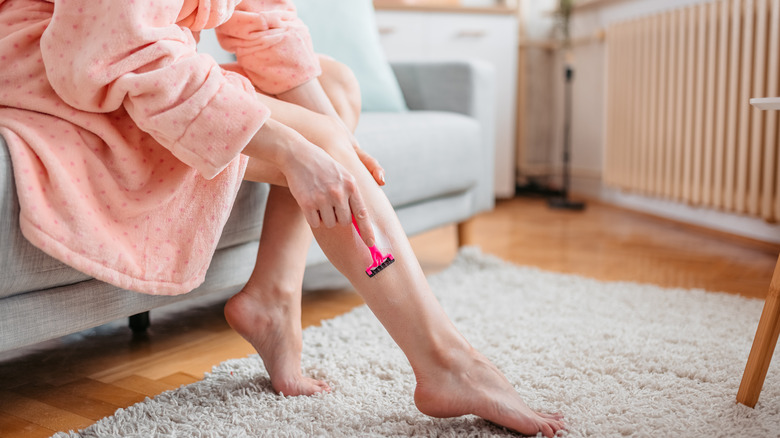Is It Skin-Safe To Shave Every Single Day? A Dermatologist Explains
Although shaving is entirely up to one's comfort and preferences, it's a typical task that many around the world do. To get soft and silky skin, you need to shave correctly to avoid ingrown hairs and razor burns. Everyone faces these issues at one point or another, but they can dampen your look. After all, no one wants to sport their favorite miniskirt or dress while covered in bandages.
No matter your reason for shaving, you need to ensure to do it carefully and patiently. Hurrying through the process will get you closer to injury and cuts. Not only are these aesthetic issues but they can also be painful and turn into infections. While many are aware of what it takes to shave correctly, many aren't aware of how many times they should be shaving. This becomes even more of an issue if you find stubs or missed spots post-shaving. Before taking another go at the same area, you must ensure that it's safe for your skin. To clear our doubts, we've enlisted Dr. Alberto de la Fuente Garcia, a board-certified Dermatologist at VIDA Wellness and Beauty with over 15 years of experience, to deduce whether or not daily shaving is healthy for your skin.
Daily shaving is safe, at least circumstantially
Thankfully, daily shaving is safe, so long as you do it correctly. In fact, Dr. De la Fuente Garcia exclusively tells Glam, "Daily shaving is generally considered safe for most skin types, as long as the correct technique and products are used. However, frequent daily shaving can irritate sensitive skin, leading to redness and inflammation." So, while you may need to shave frequently, you should avoid doing it year-round if you want to maintain the smoothest skin possible.
Shaving daily means you want to take proper precautions to ensure your skin's safety. "When shaving every day, it is important to use high-quality razor blades, a gentle moisturizing shave cream or gel, and plenty of warm water before and after to avoid razor burn," explains Dr. De la Fuente Garcia. "It is also important to use a light touch when shaving, avoiding any excessive pressure on the skin." Afterward, De. Dr la Fuente Garcia adds, you should moisturize your skin to ensure its long-term health. An oil-free moisturizer is best, as it will trap moisture in your skin without feeling greasy. These steps and precautions are the same whether you shave daily or once a week (or longer).
Getting the best shave possible
If you want to get the smoothest skin, you need to get a close enough shave to remove any appearance of hair or stubble. To get the best shave possible, you should use tools like shaving cream or gels and exfoliate before shaving. Exfoliation is key for getting the closest shave, as it removes the dead skin cells that can hide or protect the hair. Once these dead skin cells are removed, you can get a closer shave and prevent cuts. On top of exfoliating, you want to shave in the opposite direction of your hair growth. Shaving in the same direction will pull your hair back into the skin, causing ingrown hairs.
Those with sensitive skin should be more cautious about their shaving routine, as it can be easier to irate the skin. In fact, Dr. De la Fuente Garcia exclusively tells Glam, "If you have sensitive skin, it may be best to limit your shaving to every other day or a few times a week. You can also opt for professional waxing every few weeks if you prefer a longer-lasting hair removal method that's gentler on your skin." Ultimately, your shaving frequency and routine are entirely up to you and your needs, but don't let this affect how you approach your skin's health.


